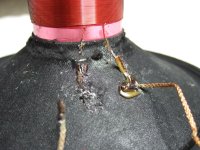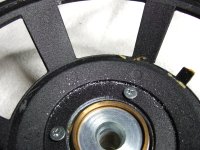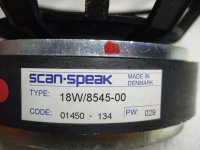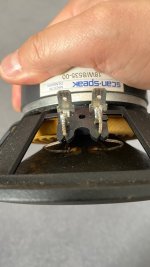Please check if they are in warranty.
If not, do it yourself, or get it done locally, or the nearest competent shop.
If not, do it yourself, or get it done locally, or the nearest competent shop.
I would be surprised if ScanSpeak doesn't answer an email with photos and details. These guys are serious when it's about aftersales or support.
As posted earlier, Scanspeak is owned by Chinese entities, had about 24 employees, and the defective units are long out of warranty.
Please keep us posted about the response from them about this problem.
Please keep us posted about the response from them about this problem.
I had a 7" driver go quiet on a ProAc speaker. Driver was not abused in any way. Found out that the flexible tinsel leads to the voice coil were open circuit. I sent the drivers to a repair service and they replaced the leads with ones that were better than the originals. Later, another driver failed in the same manner. The speakers have 4 of the same drivers per pair, so I sent all the remaining drivers, working or not, in to get the leads replaced. Speakers work well now, and I don't have to worry about another failure in the future.I have a ZRT build with two Scanspeak Revelators bass elements on each side. Last time I went to use them there was no bass. Initially I thought there was something wrong with my NAD D3020, but tried with a different amp and realised the problem were the speakers. They are about ten years old, from Madisound Speaker store.
When taken out and measures with a multimeter, they all show open circuit. They have, to my knowledge, not been playing loud and I can see absolutely no damage on any of them (except two of them which has some unrelated cat scratch cone damage). I read somewhere that these might have issues with absorbing moisture, causing rust? I'm just very confused about why they would all fail at the approximate same time. We're in Australia, and the weather here changes from humid part of the year to quite dry and hot.
There's some discolouration on the labels, am wondering if that can indicate moisture? Any ideas?
View attachment 1046735 View attachment 1046738 View attachment 1046740 View attachment 1046741
Scan speak only said the drivers are 12 years old, and to either buy new ones or find a repairer locally.
I tried softening the glue with nail polish remover on the sacrified driver(didn't have pure acetone around), but it didn't do anything. I think using a metal saw blade to carefully grind the glue down to access the wires might work though. Access to the wires is very restricted, so getting a knife in will be difficult.
I tried softening the glue with nail polish remover on the sacrified driver(didn't have pure acetone around), but it didn't do anything. I think using a metal saw blade to carefully grind the glue down to access the wires might work though. Access to the wires is very restricted, so getting a knife in will be difficult.
Contact cement / rubber solution can be softened by toluene, or gasoline.
Hot melt glue is very hard to remove except by cutting or abrasion. The white glue seems hot melt.
You can try melting as much as you can with a small soldering iron, be careful.
The other way, bit drastic, is to expose it to sunlight, that breaks it up. Risky for the cones.
Or, like they said, get it done by a professional who can salvage the cones.
At least quicker and cheaper than shipping to Denmark.
Get thick tweezers, and needle files.
A strip of abrasive paper can be glued to a bit of laminate / wood / whatever is similar to make a temporary needle file.
Use rough paper, less than 120 grit.
That will be useful where space is restricted.
Hot melt glue is very hard to remove except by cutting or abrasion. The white glue seems hot melt.
You can try melting as much as you can with a small soldering iron, be careful.
The other way, bit drastic, is to expose it to sunlight, that breaks it up. Risky for the cones.
Or, like they said, get it done by a professional who can salvage the cones.
At least quicker and cheaper than shipping to Denmark.
Get thick tweezers, and needle files.
A strip of abrasive paper can be glued to a bit of laminate / wood / whatever is similar to make a temporary needle file.
Use rough paper, less than 120 grit.
That will be useful where space is restricted.
Last edited:
I have used four Scan-Speak 18W-8542-00 in a D'Appolito config a-la Pro-ac Supertowers back in the early 90's and all of them failed recently due to -IMO - manufacturer shortcomings. In all drivers the magnets and/or pole pieces had shifted or begun to shift due to adhesive failure. One failed catastrophically and slammed the pole piece hard against one side of the voice coil thus rendering it unusable. The problem seems to be that they used Cyanoacrylate (superglue) to glue the magnets and pole pieces in place and after 20 years or so the glue let go.
I managed to strip down the remaining three drivers and reposition the magnets and pole pieces and this time they were glued using super strength Araldite. I had to fabricate semi-circular spacers to get the voice coil gap uniform when rebuilding them. To repair the damaged speaker I ordered 2 new voice-coil and cone assemblies (one as spare) from Scan-Speak via Wagner (WES) and have now repaired this speaker. The total cost was less than buying a new 18W-8542-10 from Wagner.
Today I had an 18W-8545-00 which tested open circuit. I stripped it down and found the failure was again due to Scan-Speak using the incorrect adhesive to glue the coil wires to the back of the cone where they attach to the flexible braid wires going to the connection terminals. They appear to have used a rubber based contact cement (acidic) for this purpose and it caused the copper wires to disintegrate into strips of grey-white oxide. I suspect that many other drivers in the same production run will also have failed, or will fail in similar fashion. I have fed this info back to Scan-Speak and am awaiting a reply.
All in all I am not surprised that others have experienced sudden Scan-Speak failures and my experience tells me that their quality control appears somewhat lacking - at least for some batches.
Photos attached.
I managed to strip down the remaining three drivers and reposition the magnets and pole pieces and this time they were glued using super strength Araldite. I had to fabricate semi-circular spacers to get the voice coil gap uniform when rebuilding them. To repair the damaged speaker I ordered 2 new voice-coil and cone assemblies (one as spare) from Scan-Speak via Wagner (WES) and have now repaired this speaker. The total cost was less than buying a new 18W-8542-10 from Wagner.
Today I had an 18W-8545-00 which tested open circuit. I stripped it down and found the failure was again due to Scan-Speak using the incorrect adhesive to glue the coil wires to the back of the cone where they attach to the flexible braid wires going to the connection terminals. They appear to have used a rubber based contact cement (acidic) for this purpose and it caused the copper wires to disintegrate into strips of grey-white oxide. I suspect that many other drivers in the same production run will also have failed, or will fail in similar fashion. I have fed this info back to Scan-Speak and am awaiting a reply.
All in all I am not surprised that others have experienced sudden Scan-Speak failures and my experience tells me that their quality control appears somewhat lacking - at least for some batches.
Photos attached.
Attachments
I had a pair of Scan speak 18W/8535 woofers with open circuit.
I sent them to Mike Orban of https://orbanaudio.com/ for repair. He did a fabulous job of rebuilding the coils, spiders, and leads for a very reasonable price.
I sent them to Mike Orban of https://orbanaudio.com/ for repair. He did a fabulous job of rebuilding the coils, spiders, and leads for a very reasonable price.
I have 40-year old KLH woofers with replaced surrounds and guitar amp speakers (Oxford, CTS, Eminence) which are at least a half century old, with no tinsel leads or VC.problems. Some of them have been soaked in liquids and out in the sun in 95F, high humidity, for days at a time, then taken back into the AC to be suddenly cooled. No issues. There are JBLs and other brands that have been in tropical or frozen environments, probably back and forth with no problem. It’s not the Australian weather’s fault, I blame exotic new designs and materials made with not enough testing or attention to QC for the S-S failures.So, which commercially made speakers are durable in Northern Australia?
You didn't say whether the failure was voice coil open circuit so I'll make a guess that this is the problem.
I don't like the look of that brown gunk on the flexible lead out wires on the rear of the cone. My guess is that if you can scrape the glue away you will find the copper voice coil wires attached to the flexible lead will have turned to oxide powder thus rendering the voice coil open circuit...
I don't like the look of that brown gunk on the flexible lead out wires on the rear of the cone. My guess is that if you can scrape the glue away you will find the copper voice coil wires attached to the flexible lead will have turned to oxide powder thus rendering the voice coil open circuit...
I had a friend who owned Klipsch Belles. He had blown both tweeters and it wasn't until that it was pointed out to him that he knew the difference.
can be corrosion by glue on solder point braid to coils....is know problemYes, open circuit.
Currently a bit limited on spare DIY time, so I will seek a repair solution.
Funny thing is, my parents hadn't noticed that the midwoofer had failed, even though the speaker in it was playing a LOT quieter...
ignorance is bliss...
Use leaded solder if it is possible to salvage the things.
The problem seems to have been from the time lead free solder was made compulsory, and there were a lot of solder and flux formulas.
Most people used excessively strong fluxes, and a lower than ideal temperature, so long term tendency to damage by dry joint and corrosion from flux residue are the result, damp climate makes it happen faster.
At the same time, 2004 or so, Scan-Speak was taken over by their Chinese suppliers, and they also may have tried their own formulas for joining voice coils (maybe aluminum) to copper braided tinsel, and were forced by EU rules to use lead free solder, as they were assembled from Chinese parts in Denmark.
Like above, a known problem, with known fixes earlier in this thread, basically try and make a new joint, removing the corroded part in the wires.
That will depend on the extent of the damage, and your own skills, of course.
The problem seems to have been from the time lead free solder was made compulsory, and there were a lot of solder and flux formulas.
Most people used excessively strong fluxes, and a lower than ideal temperature, so long term tendency to damage by dry joint and corrosion from flux residue are the result, damp climate makes it happen faster.
At the same time, 2004 or so, Scan-Speak was taken over by their Chinese suppliers, and they also may have tried their own formulas for joining voice coils (maybe aluminum) to copper braided tinsel, and were forced by EU rules to use lead free solder, as they were assembled from Chinese parts in Denmark.
Like above, a known problem, with known fixes earlier in this thread, basically try and make a new joint, removing the corroded part in the wires.
That will depend on the extent of the damage, and your own skills, of course.
In my opinion it is not the solder composition which leads to corrosion of the copper wire where it joins to the flexible lead-out. It is the adhesive they used to cover the joint to the rear of the cone - it appears to be quite corrosive to copper. I have come across several instances - mainly with Scan Speak drivers, where the copper voice coil wire has corroded ander the adhesive which is always a brown colour but I suspect that it was originally almost clear. The glue may even have been a contact cement. In my experience with electronics repairs I was warned by an old timer not to use where it comes into contact with copper.
In other instances I have found a similar brown adhesive has been used on printed circuit boards to cover component leads or wires and similar corrosion has occurred. The adhesive/sealant used to cover the joint on the rear of the cone must be a neutral cure material.
In other instances I have found a similar brown adhesive has been used on printed circuit boards to cover component leads or wires and similar corrosion has occurred. The adhesive/sealant used to cover the joint on the rear of the cone must be a neutral cure material.
Another concern is that wires/woven leads must be in mechanical contact with each other and not just some sort of solder bridge making the connection. There is no doubt in my mind that a solder bridge would have consequences on sound quality.
I hesitate to ask if these voice coils are a CCAW type. It all makes me cringe.
I hesitate to ask if these voice coils are a CCAW type. It all makes me cringe.
Repaired!
Yes it turns out it IS a common issue.
I didn’t even get to finish my sentence and the Speaker Doctor knew the problem and how to take care of it.
At half the replacement cost of new it’s nice to know it won’t become a paper weight.
Hopefully last another 20 years…
Yes it turns out it IS a common issue.
I didn’t even get to finish my sentence and the Speaker Doctor knew the problem and how to take care of it.
At half the replacement cost of new it’s nice to know it won’t become a paper weight.
Hopefully last another 20 years…
Last edited:
Good info. Mine are 17 years old, but so far so good. Maybe because they're only doing mid-range duty, they'll take a little longer to fail.
May you are in an area with low humidity, moisture in the air seems to make the corrosion faster.
Galvanic corrosion between aluminum and copper is accelerated in the presence of moisture.
As mentioned above, the voice coils may be CCAW, ie copper clad aluminum wound, connected to copper tinsel leads.
Strangely enough, this type of construction is also used by JBL, among others, and does not seem to be an issue with their speakers, at least I do not see posts about that in this forum.
Use some suitable solvent to clean off the flux residue, and make sure it does not go near the cones.
That will increase their life, and save you grief later, rebuilding speakers can be tedious. A sort of insurance.
Galvanic corrosion between aluminum and copper is accelerated in the presence of moisture.
As mentioned above, the voice coils may be CCAW, ie copper clad aluminum wound, connected to copper tinsel leads.
Strangely enough, this type of construction is also used by JBL, among others, and does not seem to be an issue with their speakers, at least I do not see posts about that in this forum.
Use some suitable solvent to clean off the flux residue, and make sure it does not go near the cones.
That will increase their life, and save you grief later, rebuilding speakers can be tedious. A sort of insurance.
- Home
- Loudspeakers
- Multi-Way
- Four Scanspeak Revelators dead at the same time, no visible damage



